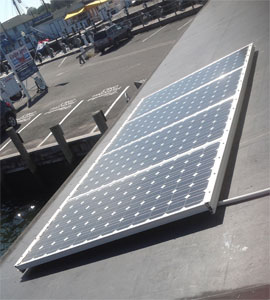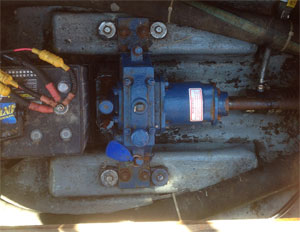Editor’s note: It’s a stretch to call a 30-foot launch a power voyaging boat, but David Berson’s plucky vessel has had a long and reliable career moving people in the waters of Greenport, N.Y. Could his electric-powered vessel have some clues for how a possible electric power voyaging boat might operate?
During the past 17 years and 12,000 trips, I’ve said pretty much the same thing over and over again to my guests after they’ve boarded my launch, Glory. “Welcome to Glory, the only Coast Guard-certified passenger-carrying vessel in the United States that is solar-charged and electric-powered. It does not pollute. It does not create any noise. And it is so environmentally friendly, if fish could vote, I would be elected president.” Folks smile, and then begin wondering how the boat works.
So here’s the story: Glory is a 30-foot, plumb-bow, fantail launch that is an exact reproduction of the original ELCO (Electric Launch Company) 30-foot launch built for the Chicago Colombian Exposition of 1893. This particular version was built in Kingston, N.Y., by Peter Fleming and Andre Melee in 1990. A hand-laid fiberglass hull with Douglas fir sole, mahogany ceiling and rail, and white oak combing and covering board, Glory is powered by eight absorbed glass mat (AGM) batteries wired in series and parallel to produce a 48-volt system. The capacity of the batteries is approximately 460 amp-hours and each 45-minute cruise consumes about 25 to 35 amp-hours. The propulsion on the boat is provided by a shunt-wound 4.5-hp, marine-duty dinosaur of a motor made by Baldor. The transmission is a Walter V-drive, and all the power is transmitted to a 15-inch three-bladed bronze wheel.
 |
|
Glory’s AGM batteries. |
One hundred days a season
Glory has been operating almost flawlessly for 100 days a season over the past 17 years from Preston’s Dock in Greenport. My partner, Andrew Rowsom and I were led to the boat in 1999 by Chuck Houghton, who was the head of ELCO at the time. Glory was sitting in Annapolis and was for sale. Most of the preliminary Coast Guard inspection work had been started and we bought the boat pursuant to getting a Certificate of Inspection as a Subchapter T passenger-carrying vessel. With a fixed firefighting system, additional bilge pumps, enclosed netting and a stability test, we received our certificate in 1999 and put the vessel to work. I hold a 200-ton license and the Coast Guard gave the boat a COI of 14 people. A few years ago the Coast Guard changed the weight regulations from 144 pounds to 188 pounds per passenger after a boating tragedy in Lake George. The Coast Guard allowed me to use the same weight capacity — 2,130 pounds — so I could carry more children, and changed the capacity to 10 and 1. This has not seriously affected business, though I thought it would. Actually, it has been beneficial because people have more room on the boat, which has perimeter seating, and have a better experience while underway.
The vessel is certificated for lakes, bays and sounds. Our cruising grounds are the waters off of Greenport in Peconic Bay, an enclosed body of water that has little groundswell.
Our first set of AGM batteries lasted 11 years. They were Concordes, but we replaced them with Deccas. The cost was approximately $500 each, and every year they are load tested to make certain that they are prepared to work all summer. Nobby Peers, a very smart and experienced engineer, is my go-to savant who yearly goes over the boat’s electrical systems. Since there are no schematics of the systems, after ELCO stopped building boats it was difficult tracking down all the information, but now we have it well sorted out.
 |
|
The 700-watt array of solar panels used to recharge Glory’s battery bank. |
Off the grid
We went off the grid in 2007, when a group of science students from Riverhead High School approached me about doing a solar installation so that Glory could be made totally green. I was very enthusiastic and Jim Moore, a former student, contributed $5,000 to put up four solar panels with the capacity of 700 watts. These panels are connected to a Sunny Boy inverter that converts the DC to AC current that we plug into the charging system of the boat. In the years since we have been off the grid, there has not been one problem with this system.
My usual day consists of four 45-minute cruises, interrupted by 45-minute charging periods at the dock. We chose not to put the solar panels on Glory because it would have both changed the stability of the vessel, thus requiring another Coast Guard stability test. Instead we placed them on the roof at Preston’s and ran a power cord from the inverter to the boat. Not the most efficient method but one that was affordable and is very effective.
The question that most folks have aboard the boat is, “Why aren’t more people doing this?”
The answer is complicated but it’s predicated, I think, on the fact that most people don’t understand how simple, effective, efficient and long-lived electric propulsion can be. Our passengers are astounded by how quiet Glory is and how, unlike other power boats they have been on, there is no smell of diesel or gasoline.
There are much more modern systems now, being made by both ELCO and Mastervolt, that offer more sophisticated motor and drive arrangements. Also, the motors are much smaller and more efficient. That is for the next generation of boaters. As for me, if my good fortune continues, then I will be running Glory until the day I hang up my license.
 |
|
Glory is equipped with four 12-volt battery chargers |
The Baldor motor is rated for 4 hp at 48 volts and about 1,600 rpm; although not a specific marine motor, it has a marine duty rating, which means all hardware and the shaft are stainless, motor mounts are double-dipped in varnish and the motor is enclosed and fan-cooled. The V-drive gearbox is a 2:1 reduction gear that keeps the prop revolutions below 800.
The bronze propeller is 15 inches with a 14-inch pitch and is a right-hand screw. The shaft is 72 inches long, made of stainless steel one-inch in diameter. It is mounted on three cutlass bearings at 16 inches designed to eliminate vibration. There is a dripless shaft log inside the boat and only one through-hull for the purpose of lubrication.
Motor controls are forward in the forepeak and reverse the motor field to change from forward to reverse. The voltage on the motor armature is varied to change the motor speed. The flow to the motor is controlled by an inner bronze wheel that goes both in reverse and forward (counterclockwise and clockwise) and controls speed and direction.
Wired for 48 volts
There are three needle gauge meters of the old iron vane movement type. There is also a digital e-meter that monitors amp-hours, voltage and charging rate when the boat is plugged in. There are 24 cells in the 48-volt system so the overall battery voltage goes from 50.4 volts when fully charged to 40.8 volts when fully drained. The digital E-meter lets me know by a series of lights the battery state of charge.
 |
|
The launch’s 48-volt Baldor electric motor. |
The batteries were originally Concorde AGM Type A deep-cycle heavy duties that are sealed and non-venting. Now we use Decca AGM and the first set lasted more than 11 years. Each battery weighs about 160 pounds and we have eight of them stowed in the bilges acting as ballast. They are trickle-charged all winter in situ and load tested before each season. There are four 12-volt battery chargers mounted in the forepeak. The boat can be plugged into a 110-volt AC outlet of 15 amps or greater.
The charging rate is dependent on ambient temperature and the discharge of the batteries, but in 17 years there has always been sufficient power at the end of the day to operate.
The hull is hand-laid mat/roving solid fiberglass. Thickness at sheer is 3/8-inch increasing at the bottom to 1/2-inch. It is laid up of six layers of 1/2-inch chopped mat and six layers of woven roving E-glass.
I have been involved with boats for most of my adult life, but never has one treated me with such grace and kindness as Glory. There has never been a breakdown, never an emergency. It is even easy for children to drive. I will be sad, very sad indeed, when my arms and legs get too old to drive her any longer.
Contributing editor David Berson has operated Glory for 17 years. He is a musician and freelance journalist and writes the ON nav problem every issue.

